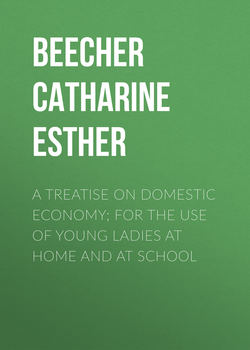Читать книгу A Treatise on Domestic Economy; For the Use of Young Ladies at Home and at School - Beecher Catharine Esther - Страница 10
CHAPTER V.
ON THE CARE OF HEALTH
NERVES
ОглавлениеThe nerves are the organs of sensation. They enable us to see, hear, feel, taste, and smell; and also combine with the bones and muscles in producing motion.
The first engraving, on p. 77, (Fig. 6,) is a vertical section of the skull, and of the spinal column, or back bone, which supports the head, and through which runs the spinal cord, whence most of the nerves originate. It is a side view, and represents the head and spine, as they would appear, if they were cut through the middle, from front to back. Fig. 7, exhibits them as they would appear, if viewed from behind. In Fig. 6, a, represents the cerebrum, or great brain; b, the cerebellum, or little brain, which is situated directly under the great brain, at the back and lower part of the head; c, d, e, is the spinal marrow, which is connected with the brain at c, and runs through the whole length of the spinal column. This column consists, as has already been stated, of a large number of small bones, f, f, called vertebræ, laid one above another, and fastened together by cartilage, or gristle, g, between them.
Fig. 6.
Fig. 7.
Between each two vertebræ, or spinal bones, there issues from the spine, on each side, a pair of nerves. The lower broad part of the spine, (see p, Fig. 1, p. 70, and Fig. 7, p. 77,) is called the sacrum; in this, are eight holes, through which the lower pairs of nerves pass off.
The nerves of the head and lungs run directly from the brain; those of all other parts of the body proceed from the spine, passing out in the manner already mentioned.
The nerves which thus proceed from the spine, branch out, like the limbs and twigs of a tree, till they extend over the whole body; and, so minutely are they divided and arranged, that a point, destitute of a nerve, cannot be found on the skin.
Some idea of the ramifications of the nerves, may be obtained by reference to the following engraving, (Fig. 8.) In this, A, A, represents the cerebrum, or great brain; B, B, the cerebellum, or little brain; (see also a, b, in Fig. 6;) C, C, represents the union of the fibres of the cerebrum; D, D, the union of the two sides of the cerebellum; E, E, E, the spinal marrow, which passes through the centre of the spine, (as seen at c, d, e, in Fig. 6;) 1, 2, 3, 4, 5, 6, branches of the nerves going to different parts of the body. As the nerves are the organs of sensation, all pain is an affection of some portion of the nerves. The health of the nerves depends very greatly on the exercise of the muscles, with which they are so intimately connected. This shows the reason why the headache, tic douloureux, diseases of the spine, and other nervous affections, are so common among American women. Their inactive habits, engender a debility of the nervous system, and these diseases follow, as the consequence.
Fig. 8.
It can be seen, by a reference to the side view, represented on page 77, (Fig. 6,) that the spine is naturally curved back and forward. When, from want of exercise, its bones are softened, and the muscles weakened, the spine acquires an improper curve, and the person becomes what is called crooked, having the neck projected forward, and, in some cases, having the back convex, where it should be concave. Probably one half of the American women have the head thus projecting forward, instead of carrying it in the natural, erect position, which is both graceful and dignified.
The curvature of the spine, spoken of in this work as so common, and as the cause of so many diseases among American women, is what is denominated the lateral curvature, and is much more dangerous than the other distortion. The indications of this evil, are, the projection of one shoulder blade more than the other, and, in bad cases, one shoulder being higher, and the hip on the opposite side more projecting, than the other. In this case, the spine, when viewed from behind, instead of running in a straight line, (as in Fig. 7 and 9,) is curved somewhat, as may be seen in Figures 10 and 11.
This effect is occasioned by the softness of the bones, induced by want of exercise, together with tight dressing, which tends to weaken the muscles that are thus thrown out of use. Improper and long continued positions in drawing, writing, and sleeping, which throw the weight of the body on one part of the spine, induce the same evil. This distortion is usually accompanied with some consequent disease of the nervous system, or some disarrangement of the internal organs.
By comparing Figures 9 and 11, the difference between a natural and distorted spine will be readily perceived. In Fig. 10, the curved line shows the course of the spine, occasioned by distortion; the perpendicular line, in this and Fig. 11, indicates the true direction of the spine; the horizontal lines show that one shoulder and hip are forced from their proper level.
Fig. 9.
Fig. 10.
Fig. 11.
